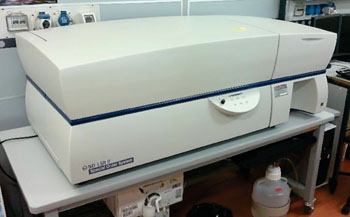Blood Processing Methods Affect Microparticles Linked To Transfusion Reactions
By LabMedica International staff writers
Posted on 29 Apr 2016
Specific red blood cell manufacturing methods may be less damaging to cells than others and knowledge of this could help reduce adverse reactions in transfusion recipients and may impact the future of how blood is collected around the world.Posted on 29 Apr 2016
Scientists have looked at the levels of microparticles and mitochondrial DNA (mtDNA) present in blood that can indicate cellular damage. Studying red blood cell units manufactured using nine different processes; they observed clear differences in the extent of damage across the nine methods.

Image: The BD LSR II benchtop flow cytometer (Photo courtesy of Becton Dickinson).
A team of scientists led by those at the Blood Systems Research Institute (San Francisco, CA, USA) prepared 87 red cell concentrates (RCCs) using nine different methods (six to 15 units/method), including three apheresis, five whole blood (WB)-derived leucoreduced (LR) and one WB-derived non-LR method. On storage days five and 42, levels of mtDNA were measured by polymerase chain reaction (PCR), and number and cell of origin of extracellular vesicle (EVs) were studies by flow cytometry and were assessed in RCC supernatants.
Red blood cell (RBC) and residual platelet (rPLT) counts were measured using a Coulter AcT 8 hematology analyzer (Beckman Coulter Inc., Fullerton, CA, USA). Residual white blood cell (WBC) counts were measured by flow cytometry with the LeukoSure WBC enumeration kit. MtDNA quantification was implemented after DNA extraction and real-time PCR were performed on a LightCycler 480 II sequence detection system (Roche, Basel, Switzerland). EVs quantification were assessed by flow cytometry, using a 3-laser (blue 488 nm, violet 405 nm, and red 633 nm) LSR II benchtop flow cytometer (Becton Dickinson, Franklin Lakes, NJ, USA).
The team found that here was a 100-fold difference in mtDNA levels among methods, with highest levels in non-LR, followed by MCS+ and Trima apheresis RCCs. There was a 10-fold difference in EV levels among methods. RBC-derived CD235a+ EVs were found in fresh RCCs and increased in most during storage. Platelet-derived CD41a+ EVs were highest in non-LR and Trima RCCs and did not change during storage. WBC-derived EVs were low in most RCCs; CD14+ EVs increased in several RCCs during storage.
Sonia Bakkour, PhD, the lead investigator said, “Our study showed that those molecular patterns are present and that their levels and composition are different based on the red cell manufacturing process, that is the process and materials used to collect or prepare red cells for transfusion. This tells us that some manufacturing processes cause less damage to the red blood cells than others.” The study was published on April 11, 2016, in the journal Vox Sanguinis.
Related Links:
Blood Systems Research Institute
Beckman Coulter
Roche
Becton Dickinson













